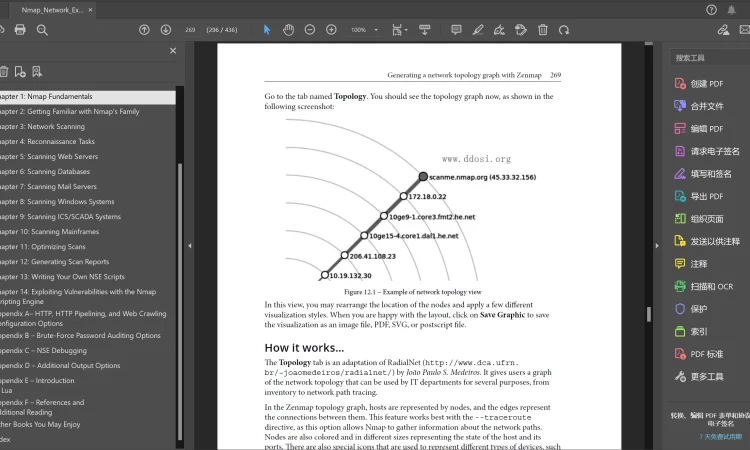目录导航
Nmap Network Exploration and Security Auditing Cookbook Third Edition
pdf书籍,英文版,英语不好者慎入.
共计436页
书籍目录[英文]
Chapter 1: Nmap Fundamentals
Technical requirements
Building Nmap's source code
Finding online hosts
Listing open ports on a target
Fingerprinting OSes and services running on a target
Using NSE scripts against a target host
Scanning random targets on the internet
Collecting signatures of web servers
Scanning with Rainmap Lite
Chapter 2: Getting Familiar with Nmap's Family
Monitoring servers remotely with Nmap and Ndiff
Crafting ICMP echo replies with Nping
Managing multiple scanning profiles with Zenmap
Running Lua scripts against a network connection with Ncat
Discovering systems with weak passwords with Ncrack
Using Ncat to diagnose a network client
Defending against Nmap service detection scans
Chapter 3: Network Scanning
Discovering hosts with TCP SYN ping scans
Discovering hosts with TCP ACK ping scans
Discovering hosts with UDP ping scans
Selecting ports in UDP ping scans
Discovering hosts with ICMP ping scans
Discovering hosts with SCTP INIT ping scans
Discovering hosts with IP protocol ping scans
Discovering hosts with ARP ping scans
Performing advanced ping scans
Discovering hosts with broadcast ping scans
Scanning IPv6 addresses
Spoofing the origin IP of a scan
Using port scanning for host discovery
Chapter 4: Reconnaissance Tasks
Performing IP address geolocation
Getting information from WHOIS records
Obtaining traceroute geolocation information
Querying Shodan to obtain target information
Collecting valid email accounts and IP addresses from web servers
Discovering hostnames pointing to the same IP address
Discovering hostnames by brute-forcing DNS records
Matching services with public vulnerability advisories and picking the low-hanging fruit
Chapter 5: Scanning Web Servers
Listing supported HTTP methods
Discovering interesting files and folders on web servers
Brute forcing HTTP authentication
Brute forcing web applications
Detecting web application firewalls
Detecting possible XST vulnerabilities
Detecting XSS vulnerabilities
Finding SQL injection vulnerabilities
There's more…
Finding web applications with default credentials
Detecting insecure cross-domain policies
Detecting exposed source code control systems
Auditing the strength of cipher suites in SSL servers
Chapter 6: Scanning Databases
Listing MySQL databases
Listing MySQL users
Listing MySQL variables
Brute forcing MySQL passwords
Finding root accounts with an empty password in MySQL servers
Detecting insecure configurations in MySQL servers
Brute forcing Oracle passwords
Brute forcing Oracle SID names
Retrieving information from MS SQL servers
Brute forcing MS SQL passwords
Dumping password hashes of MS SQL servers
Running commands through xp_cmdshell in MS SQL servers
Finding system administrator accounts with empty passwords in MS SQL servers
Obtaining information from MS SQL servers with NTLM enabled
Retrieving MongoDB server information
Detecting MongoDB instances with no authentication enabled
Listing MongoDB databases
Listing CouchDB databases
Retrieving CouchDB database statistics
Detecting Cassandra databases with no authentication enabled
Brute forcing Redis passwords
Chapter 7: Scanning Mail Servers
Detecting SMTP open relays
Brute-forcing SMTP passwords
Detecting suspicious SMTP servers
Enumerating SMTP usernames
Brute-forcing IMAP passwords
Retrieving the capabilities of an IMAP server
Brute-forcing POP3 passwords
Retrieving the capabilities of a POP3 server
Retrieving information from SMTP servers with NTLM authentication
Chapter 8: Scanning Windows Systems
Obtaining system information from SMB
Detecting Windows clients with SMB signing disabled
Detecting IIS web servers that disclose Windows 8.3 names
Detecting Windows hosts vulnerable to MS08-067 and MS17-010
Retrieving the NetBIOS name and MAC address of a host
Enumerating user accounts of Windows targets
Enumerating shared folders
Enumerating SMB sessions
Finding domain controllers
There's more…
Detecting the Shadow Brokers' DOUBLEPULSAR SMB implants
Listing supported SMB protocols
Detecting vulnerabilities using the SMB2/3 boot-time field
Detecting whether encryption is enforced in SMB servers
Chapter 9: Scanning ICS/SCADA Systems
Finding common ports used in ICS/SCADA systems
Finding HMI systems
Enumerating Siemens SIMATIC S7 PLCs
Enumerating Modbus devices
Enumerating BACnet devices
Enumerating Ethernet/IP devices
Enumerating Niagara Fox devices
Enumerating ProConOS devices
Enumerating Omrom PLC devices
Enumerating PCWorx devices
Chapter 10: Scanning Mainframes
Listing CICS transaction IDs in IBM mainframes
Enumerating CICS user IDs for the CESL/CESN login screen
Brute-forcing z/OS JES NJE node names
Enumerating z/OS TSO user IDs
Brute-forcing z/OS TSO accounts
Listing VTAM application screens
Chapter 11: Optimizing Scans
Skipping phases to speed up scans
Selecting the correct timing template
Adjusting timing parameters
Adjusting performance parameters
Adjusting scan groups
Distributing a scan among several clients using dnmap
Chapter 12: Generating Scan Reports
Saving scan results in a normal format
Saving scan results in an XML format
Saving scan results to a SQLite database
Saving scan results in a grepable format
Generating a network topology graph with Zenmap
Generating HTML scan reports
Reporting vulnerability checks
Generating PDF reports with fop
Saving NSE reports in Elasticsearch
Visualizing Nmap scan results with IVRE
Chapter 13: Writing Your Own NSE Scripts
Making HTTP requests to identify vulnerable Supermicro IPMI/BMC controllers
Sending UDP payloads using NSE sockets
Generating vulnerability reports in NSE scripts
Exploiting an SMB vulnerability
Writing brute-force password auditing scripts
Crawling web servers to detect vulnerabilities
Working with NSE threads, condition variables, and mutexes in NSE
Writing a new NSE library in Lua
Writing a new NSE library in C/C++
Getting your scripts ready for submission
Chapter 14: Exploiting Vulnerabilities with the Nmap Scripting Engine
Generating vulnerability reports in NSE scripts
Writing brute-force password auditing scripts
Crawling web servers to detect vulnerabilities
Exploiting SMB vulnerabilities
Appendix A– HTTP, HTTP Pipelining, and Web Crawling Configuration Options
HTTP user agent
HTTP pipelining
Configuring the NSE httpspider library
Appendix B – Brute-Force Password Auditing Options
Brute modes
Appendix C – NSE Debugging
Debugging NSE scripts
Exception handling
Appendix D – Additional Output Options
Saving output in all formats
Appending Nmap output logs
Including debugging information in output logs
Including the reason for a port or host state
OS detection in verbose mode
Appendix E – Introduction to Lua
Flow control structures
Conditional statements – if, then, elseif
Loops – while
Loops – repeat
Loops – for-www.ddosi.org
Data types
String handling
Character classes
Magic characters
Patterns
Captures
Repetition operators
Concatenation
Finding substrings
String repetition
String length
Formatting strings
Splitting and joining strings
Common data structures
Tables
Arrays
Linked lists
Sets
Queues
Custom data structures
I/O operations
Modes
Opening a file
Reading a file
Writing a file
Closing a file
Coroutines
Creating a coroutine
Executing a coroutine
Determining the current coroutine
Getting the status of a coroutine
Yielding a coroutine
Metatables
Arithmetic metamethods
Relational metamethods
Things to remember when working with Lua
Comments
Dummy assignments
Indexes
Semantics
Coercion
Safe language
Booleans
Appendix F – References and Additional Reading书籍目录[中文翻译-机翻!]
第 1 章:Nmap 基础
技术要求
构建 Nmap 的源代码
查找在线主机
列出目标上的开放端口 对目标上
运行的操作系统和服务进行指纹识别
对目标主机使用 NSE 脚本
扫描互联网上的随机目标
收集 Web 服务器的签名
使用 Rainmap Lite 进行扫描
第 2 章:熟悉 Nmap 的家庭
使用 Nmap 和 Ndiff 远程监控服务器 使用 Nping
制作 ICMP 回显 使用 Zenmap
管理多个扫描配置文件 使用 Ncat
针对网络连接运行 Lua 脚本
使用 Ncrack发现具有弱密码的系统
使用 Ncat 诊断网络客户端
防御 Nmap 服务检测扫描
第 3 章:网络扫描
使用 TCP SYN ping 扫描
发现主机 使用 TCP ACK ping 扫描
发现主机 使用 UDP ping扫描发现主机 在 UDP ping
中选择端口scans
使用 ICMP ping 扫描
发现主机 使用 SCTP INIT ping 扫描
发现主机 使用 IP 协议 ping 扫描
发现主机 使用 ARP ping扫描发现主机
执行高级 ping 扫描
使用广播 ping 扫描发现主机
扫描 IPv6 地址
欺骗扫描的源 IP
使用端口扫描进行主机发现
第 4 章:侦察任务
执行 IP 地址地理定位
从 WHOIS 记录中
获取信息 获取 traceroute 地理定位信息
查询 Shodan 以获取目标信息
从 Web 服务器收集有效的电子邮件帐户和 IP 地址
发现主机名指向到同一个 IP 地址
通过暴力破解 DNS 记录来发现主机名 将
服务与公共漏洞公告相匹配并采摘容易获得的果实
第 5 章:扫描 Web 服务器
列出支持的 HTTP 方法
在 Web 服务器上发现有趣的文件和文件夹
蛮力 HTTP 身份验证
蛮力 Web 应用程序
检测 Web 应用程序防火墙
检测可能的 XST 漏洞
检测 XSS 漏洞
查找 SQL 注入漏洞
还有更多……
查找具有默认凭据的 Web 应用程序
检测不安全的跨域策略
检测暴露的源代码控制系统
审计 SSL 服务器中密码套件的强度
第 6 章:扫描数据库
列出 MySQL 数据库
列出 MySQL 用户
列出 MySQL 变量
暴力破解
MySQL 密码 在 MySQL 服务器中查找密码为空的 root 帐户
检测 MySQL 服务器中的不安全配置
暴力破解 Oracle 密码
暴力破解 Oracle SID 名称
从 MS SQL 服务器检索信息
暴力破解 MS SQL 密码
转储 MS SQL 服务器的密码哈希
运行命令MS SQL 服务器中的 xp_cmdshell 在 MS SQL 服务器中
查找密码为空的系统管理员帐户
从启用 NTLM 的 MS SQL 服务器获取信息
检索 MongoDB 服务器信息
检测未启用身份验证的 MongoDB 实例
列出 MongoDB 数据库
列出 CouchDB 数据库
检索 CouchDB 数据库统计信息 检测
未启用身份验证的 Cassandra 数据库
暴力破解 Redis 密码
第 7 章:扫描邮件服务器
检测 SMTP 开放中继
暴力破解 SMTP 密码
检测可疑 SMTP 服务器
枚举 SMTP 用户名
暴力破解 IMAP 密码
IMAP 服务器
暴力破解 POP3 密码
检索 POP3 服务器的功能
通过 NTLM 身份验证从 SMTP 服务器检索信息
第 8 章:扫描 Windows 系统
从 SMB 获取系统信息
检测禁用 SMB 签名的 Windows 客户端
检测泄露 Windows 8.3 名称的 IIS Web 服务器
检测易受 MS08-067 和 MS17-010 攻击的 Windows 主机
检索主机的 NetBIOS 名称和 MAC 地址
枚举 Windows 目标的用户帐户
枚举共享文件夹
枚举 SMB 会话
查找域控制器
还有更多……
检测 Shadow Brokers 的 DOUBLEPULSAR SMB 植入物
列出支持的 SMB 协议
使用 SMB2/3 启动时间字段
检测漏洞 检测 SMB 服务器中是否实施了加密
第 9 章:扫描 ICS/SCADA 系统
查找 ICS/SCADA 系统中使用的通用端口
查找 HMI 系统
枚举 Siemens SIMATIC S7 PLC
枚举 Modbus 设备
枚举 BACnet 设备
枚举 Ethernet/IP 设备
枚举 Niagara Fox 设备
枚举 ProConOS 设备
枚举 Omrom PLC 设备
枚举 PCWorx 设备
第 10 章:扫描大型机
列出 CICS 事务IBM 大型机中
的 ID 枚举 CESL/CESN 登录屏幕的 CICS 用户 ID暴力破解
z/OS JES NJE 节点名称
枚举 z/OS TSO 用户 ID
暴力破解 z/OS TSO 帐户
列出 VTAM 应用程序屏幕
第 11 章:优化扫描
跳过阶段以加快扫描速度
选择正确的定时模板
调整定时参数
调整性能参数
调整扫描组
使用 dnmap 在多个客户端之间分发扫描
第 12 章:生成扫描报告
以正常格式
保存扫描结果 将扫描结果保存在XML 格式
将扫描结果保存到 SQLite 数据库
以 grepable 格式保存扫描结果 使用 Zenmap
生成网络拓扑图
生成 HTML 扫描报告
报告漏洞检查
使用 fop 生成 PDF 报告
在 Elasticsearch 中保存 NSE 报告
使用 IVRE 可视化 Nmap 扫描结果
第 13 章:编写您自己的 NSE 脚本
发出 HTTP 请求以识别易受攻击的 Supermicro IPMI/BMC 控制器
使用 NSE 套接字发送 UDP 有效负载
在 NSE 脚本中生成漏洞报告
利用 SMB 漏洞
编写蛮力密码审计脚本
爬取 Web 服务器以检测漏洞
在 NSE 中使用 NSE 线程、条件变量和互斥锁 用
Lua
编写新的 NSE 库 用 C/C++ 编写新的 NSE 库
准备好提交脚本
第 14 章:利用 Nmap 脚本引擎利用漏洞
在 NSE 脚本中生成漏洞报告
编写暴力密码审计脚本
爬网服务器以检测漏洞
利用 SMB 漏洞
附录 A - HTTP、HTTP 流水线和 Web 爬网配置选项
HTTP 用户代理
HTTP 流水线
配置 NSE httpspider 库
附录 B – 蛮力密码审计选项
蛮力模式
附录 C – NSE 调试
调试 NSE 脚本
异常处理
附录 D – 附加输出选项
以所有格式保存输出
附加 Nmap 输出日志
在输出日志中包含调试信息
包括端口或主机状态的原因
详细模式下操作系统检测的原因
附录 E – Lua
流控制结构简介
条件语句 – if, then, elseif
Loops – while
Loops – repeat
Loops – for
数据类型
字符串处理
字符类
魔术字符
模式
捕获
重复运算符
串联
查找子
字符串 字符串重复
字符串长度
格式化字符串
拆分和连接字符串
常用数据结构
表格
数组
链表
集合
队列
自定义数据结构
I/O 操作
模式
打开文件
读取文件
写入文件
关闭文件
协
程 创建协程
执行协程
确定当前协程
获取协程状态
生成协程
元表
算术元方法
关系元方法
使用 Lua 时要记住的
事情
虚拟分配
索引
语义
强制
安全语言
布尔附录 F – 参考和附加阅读
截图
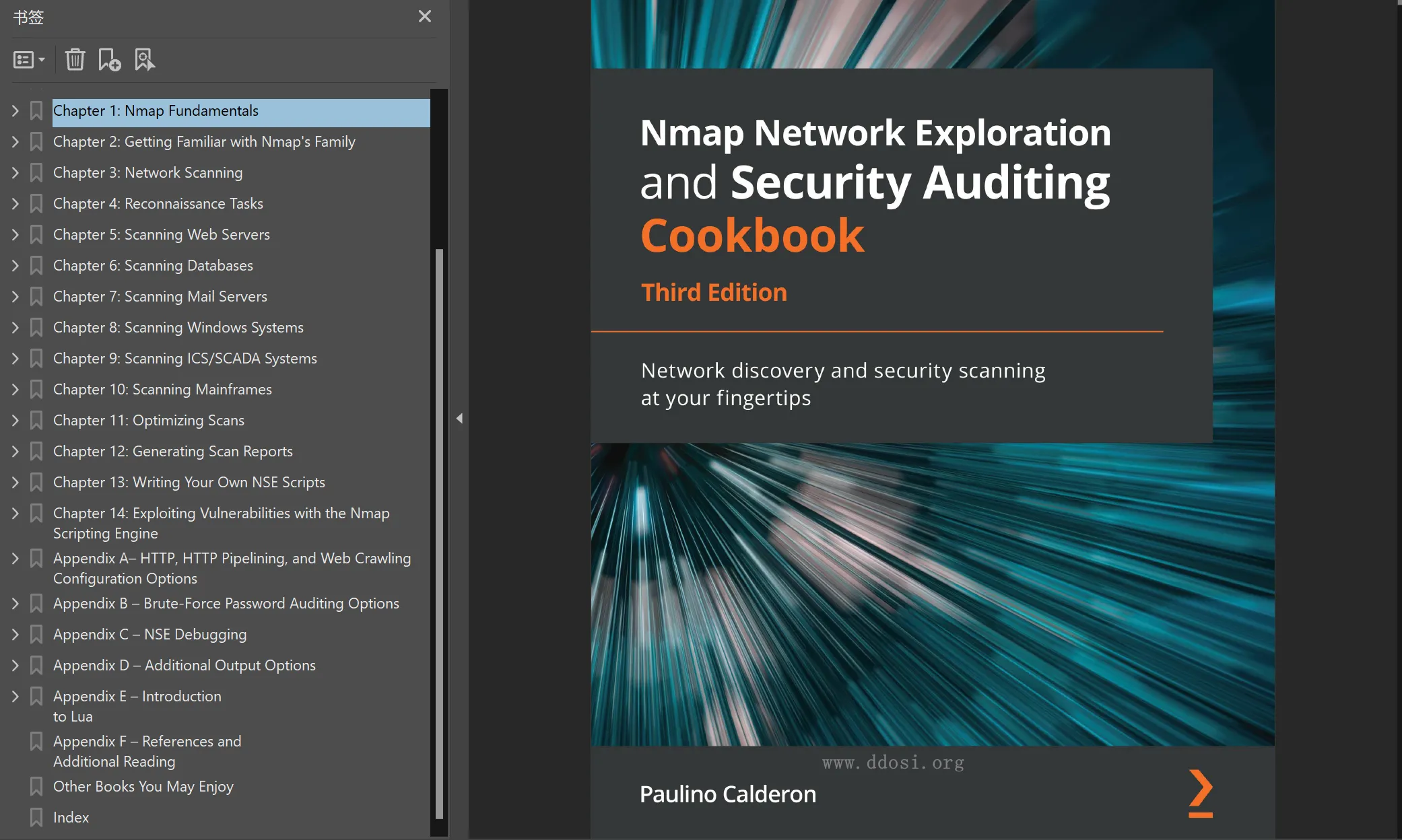
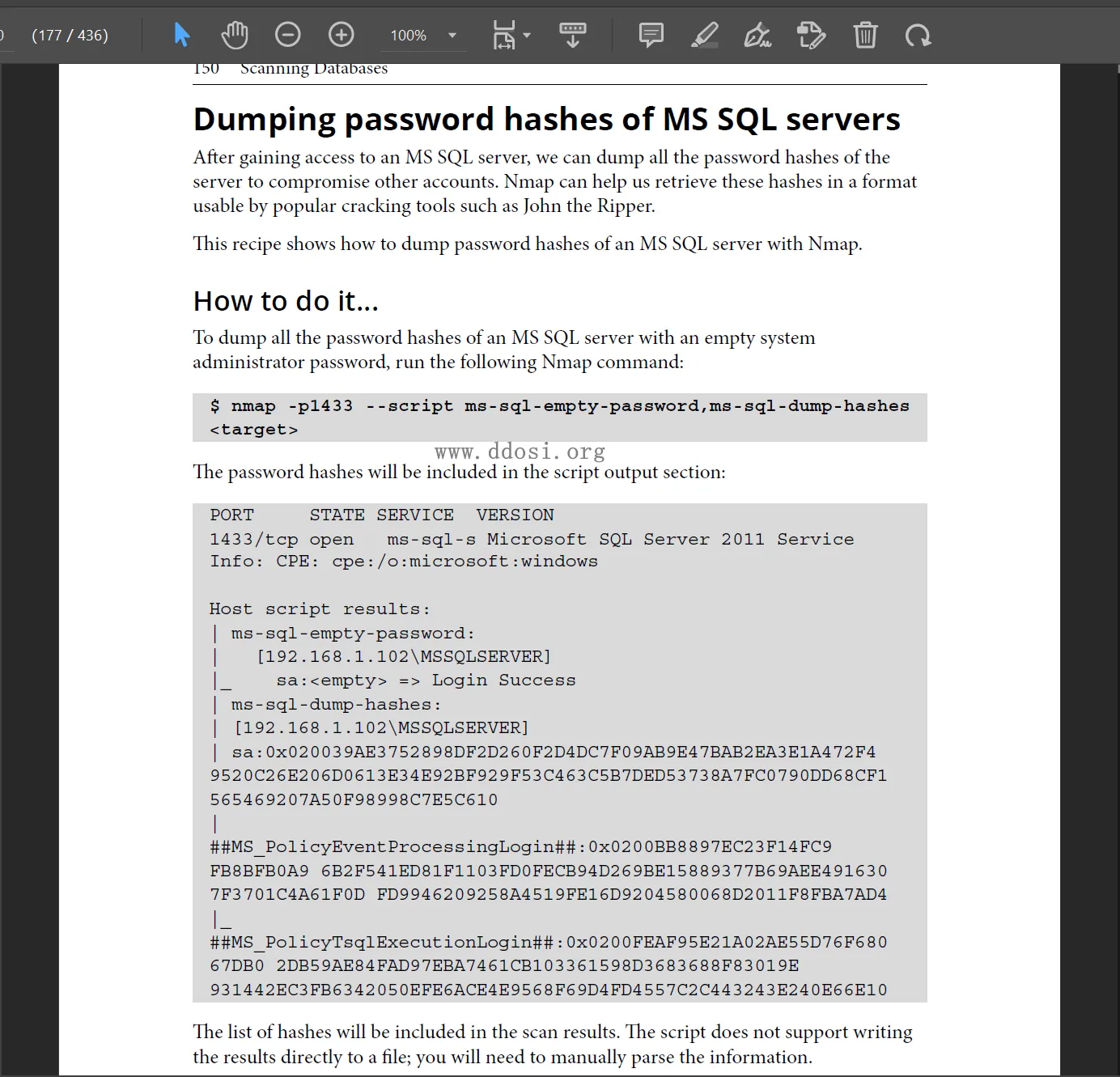
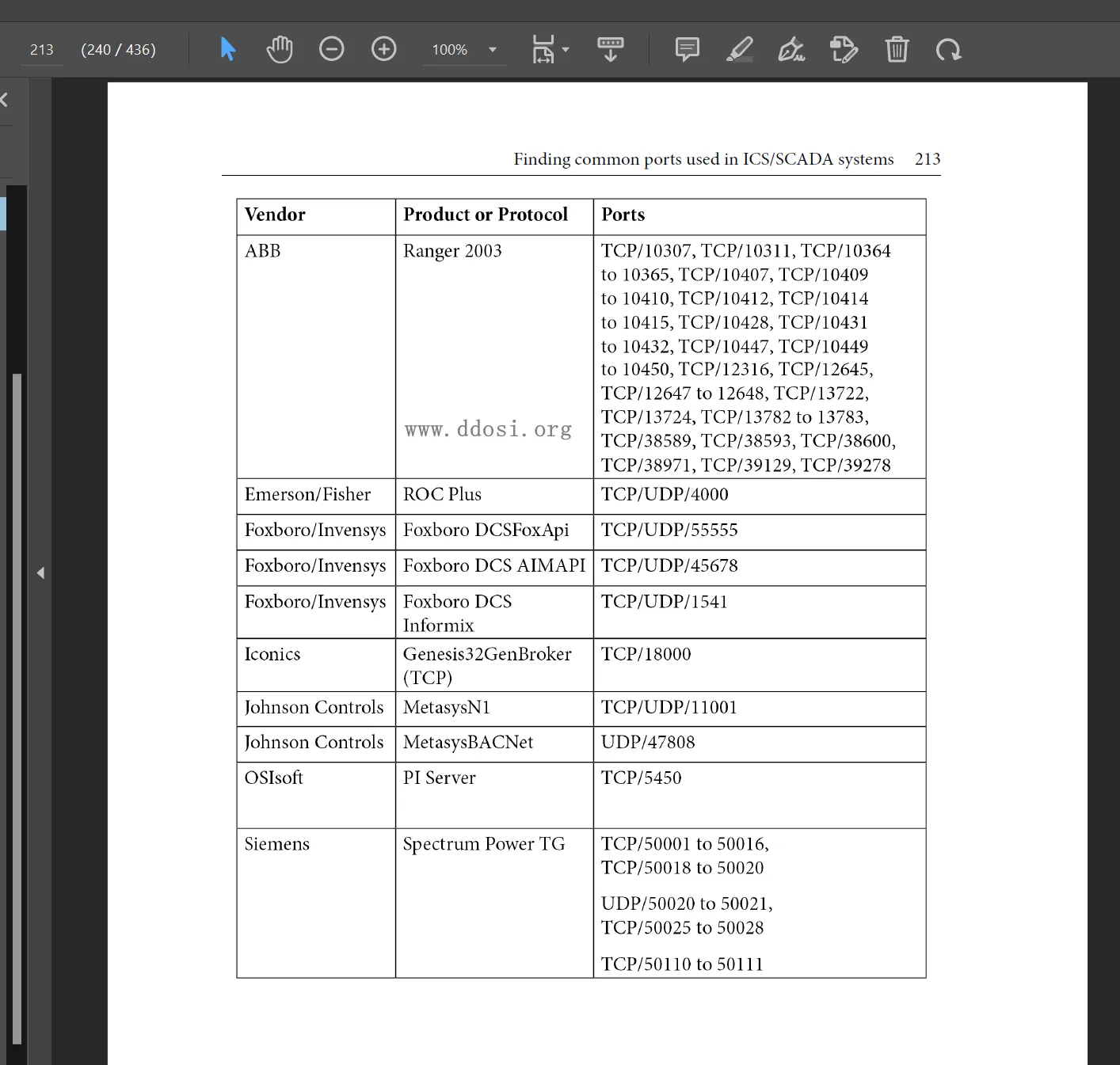
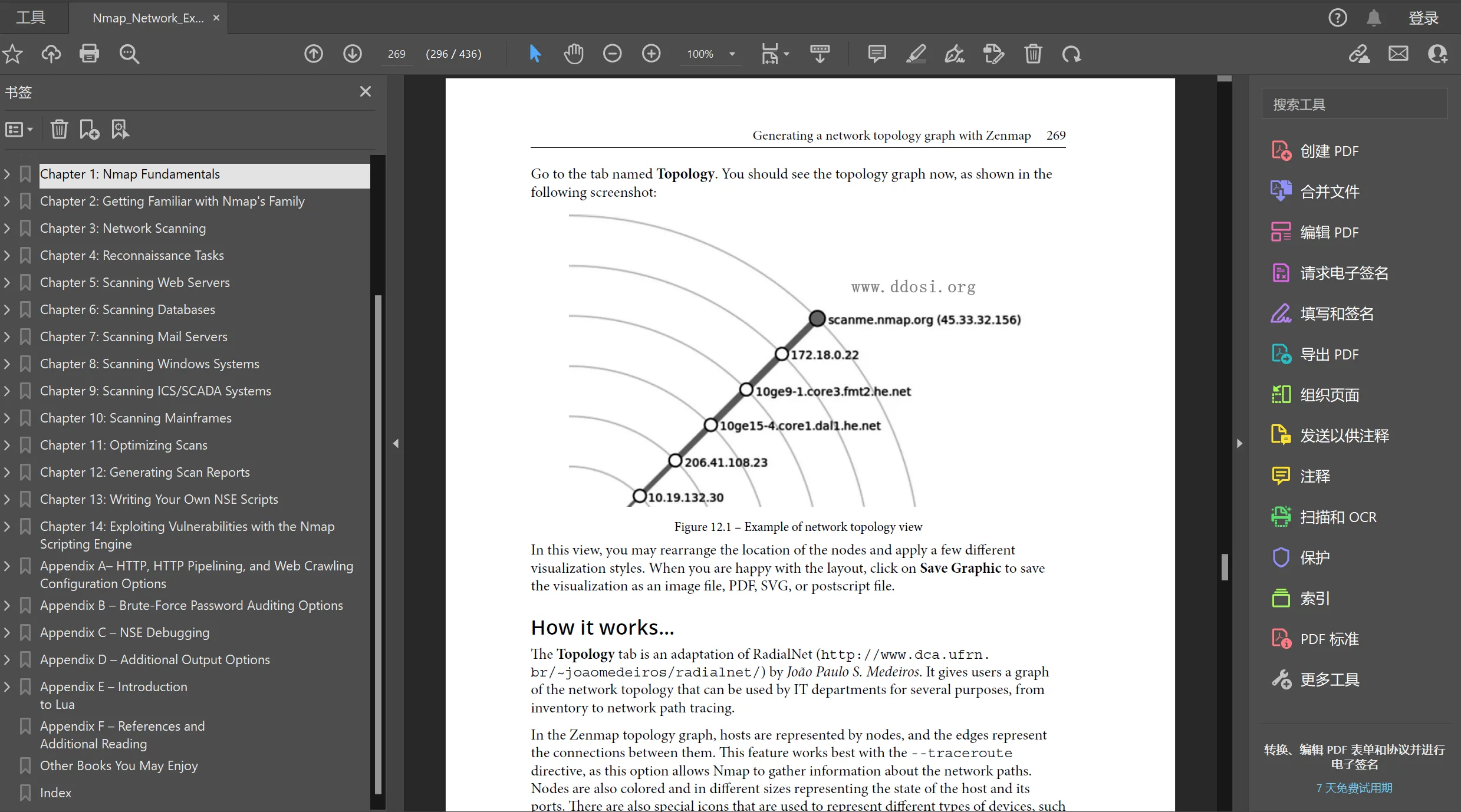
PDF下载地址
云中转网盘:
Nmap_Network_Exploration_and_Security_Auditing_Cookbook_Network.pdf
转载请注明出处及链接

